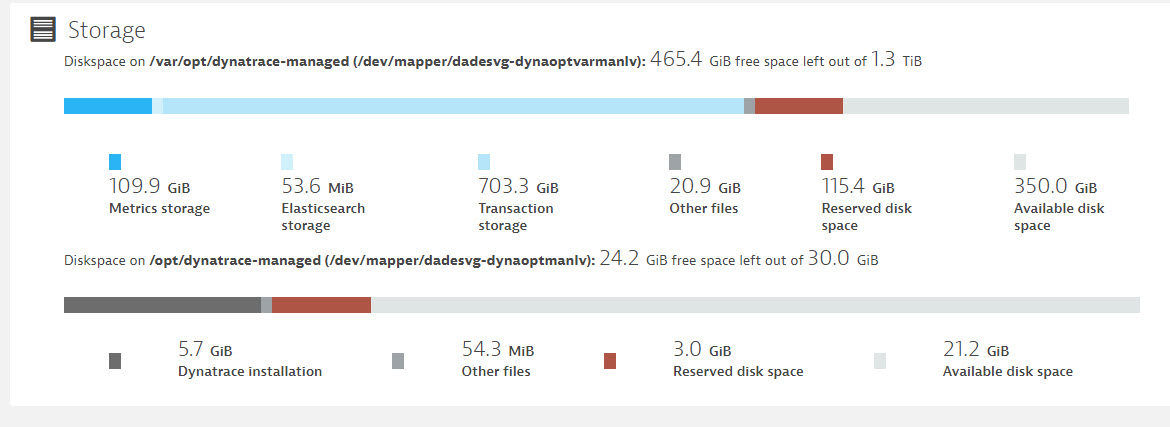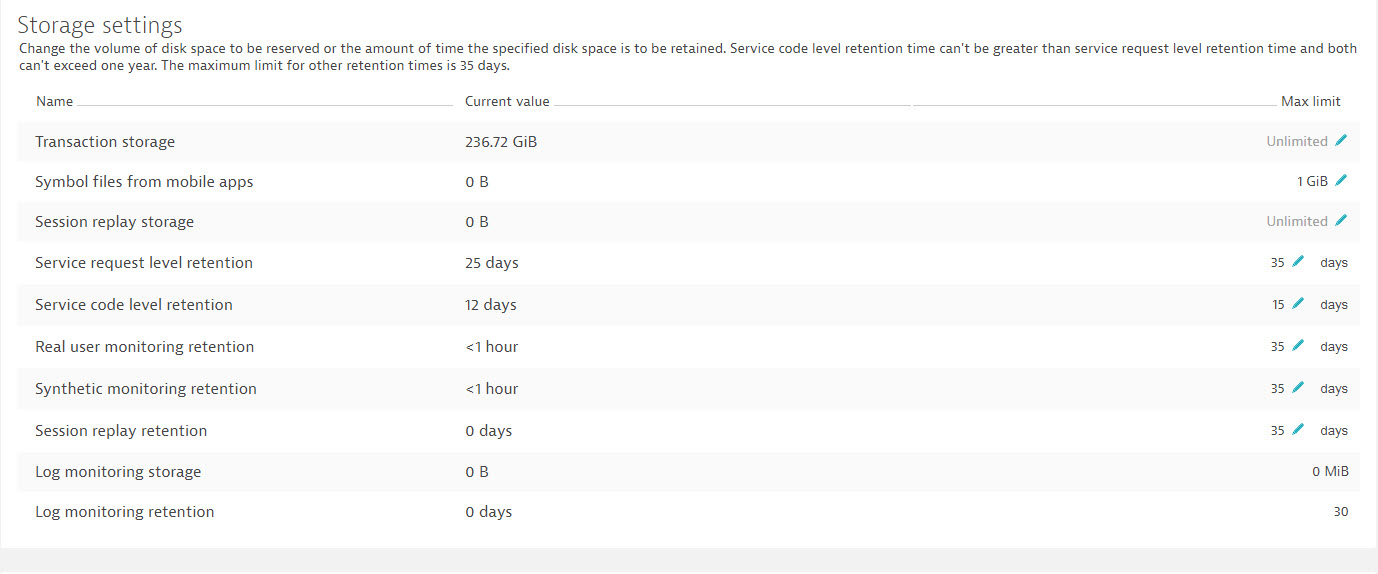- Mark as New
- Subscribe to RSS Feed
- Permalink
27 May 2020
04:11 PM
- last edited on
13 Jun 2023
03:53 PM
by
![]() Karolina_Linda
Karolina_Linda
Hi masters,
I've some doubts in reference to Transaction storage on Dynatrace Managed:
1.- Exactly what information are stored in each one of these sections:

- Metrics storage: I understand that it is the Cassandra that according to the documentation is unlimited, this cannot be configured in each environment, right?
- Elasticsearch storage: What is stored here? What options does this value refer to and how can they be limited by environment?
- Transaction storage: Does it contain the combination of service request level retention and service code level retention? Amy more data, RUM? If this is true:
- How do you distribute it?
- What happens if you run out of space?
- Other files: What does it contain?
- Reserved disk space: What does it contain?
2.- At the configuration level of each environment, where each of the configurable data goes:

3.- What happens if the transaction storage limit is reached? What data deletes first?
Thanks in advance!
Josep Maria
Solved! Go to Solution.
- Labels:
-
cassandra
-
dynatrace managed
- Mark as New
- Subscribe to RSS Feed
- Permalink
27 May 2020
05:02 PM
- last edited on
17 Mar 2025
02:54 PM
by
![]() MaciejNeumann
MaciejNeumann
This link should provide answers to the questions you are asking: Managed hardware requirements Dynatrace will always phase out the oldest and replace it whenever a defined limit is reached (rolling). The transaction Storage is actually set to unlimited in you screen shot so you should be good.
- Mark as New
- Subscribe to RSS Feed
- Permalink
28 May 2020 08:05 AM
Hi @Chad T.
thanks for you response, another question around this:
how Dynatrace determines the size assigned for the Cassandra, ELK and Transaction Storage (if we don't have the filesystems separated as recommended).
My concern is if we have a filesystem for everything (Cassandra, ELK and Transaction Storage) and it is too small to store all the data based on the configured retention, which of them are deleted and with what criteria?
Thank you!
- Mark as New
- Subscribe to RSS Feed
- Permalink
28 May 2020 08:14 AM
Transaction storage is truncated as it is least important (you will loose old purepaths).
If Cassandra or Elastic does not have enough place, your cluster node will become unhealthy and stop working.
I believe you will be contacted before this happens by DynatraceOne.
- Mark as New
- Subscribe to RSS Feed
- Permalink
27 May 2020 09:53 PM
- Metrics storage: I understand that it is the Cassandra that according to the documentation is unlimited, this cannot be configured in each environment, right?
Correct.
- Elasticsearch storage: What is stored here? What options does this value refer to and how can they be limited by environment?
Users session for example. Some settings can be set for the environment (real user monitoring retention)
- Transaction storage: Does it contain the combination of service request level retention and service code level retention? Amy more data, RUM? If this is true:
- How do you distribute it?
- What happens if you run out of space?
As @Chad T. already mentioned, it is phased out. Oldest data is truncated if there is lack of space.
- Other files: What does it contain?
As it says - other files. Typically installation images for agents.
- Reserved disk space: What does it contain?
As it says - reserved space. It's reserved for Cassandra data compaction, AFAIK this has to be at least the amount of Metrics storage.
- Mark as New
- Subscribe to RSS Feed
- Permalink
28 May 2020 08:12 AM
Hi @Julius L.
some questions around this and the @Chad T. response:
1.- The Transaction Storage is composed by the combination of service request level retention and service code level retention? The limit configured in each environment applies only to Transaction Storage?
2.- what about the cassandra, it's global and can' t be configures per environement?
Regards!



